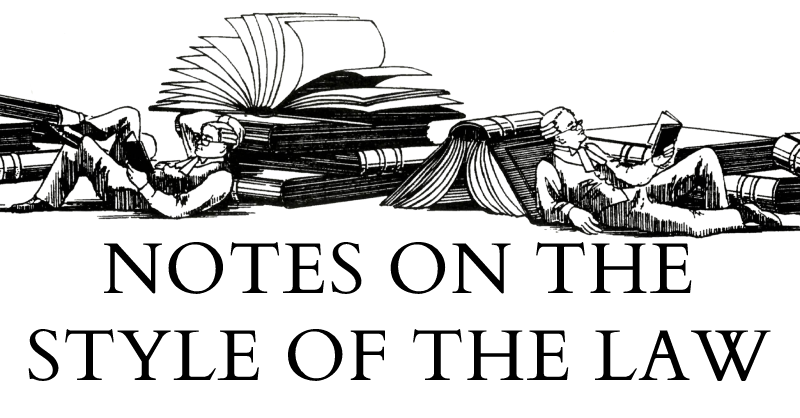

Simplicity is not always best. The skilled writer may for good reason choose to add complexity and sophistication, particularly in legal writing where precision is essential. However, the key phrase in this statement of principle is ‘for good reason’. Complexity should occur only where the writer, in her considered judgment, considers it necessary. Pointless complexity is, at best, discourteous to the reader and, at worst, confusing or obscurantist. Thus, when legal language uses a complex or specialised term, the first question must be: ‘Is there a good reason to use this term?’
The term ‘factual matrix’ is a staple of the law, particularly in the law of contract (though it does occur occasionally in other areas). In this Note, ‘factual matrix’ shall be put in the dock, accused of violating the aforementioned principle by being needlessly complex without reason. To whit, ‘factual matrix’ stands accused of adding nothing to legal language which cannot be achieved by existing clear English words.
To understand why this term is otiose, we should begin at the beginning. Using only database searches (which have lacunæ and blind spots), it is not possible to say with absolute certainty when the first ever use of ‘matrix’ (vel sim) in relation to ‘facts’ (vel sim) occurred. However, we can locate the effective fons et origo of the modern craze for the use of ‘factual matrix’ in judgments was in the speech of the Lord Wilberforce in the 1971 case of Prenn v Simmonds. [1971] 1 WLR 1381, HL In that case, His Lordship wrote (emphasis added):
The time has long passed when agreements, even those under seal, were isolated from the matrix of facts in which they were set and interpreted purely on internal linguistic considerations. […] We must […] inquire beyond the language and see what the circumstances were with reference to which the words were used, and the object, appearing from those circumstances, which the person using them had in view. Moreover, […] it has been clear enough that evidence of mutually known facts may be admitted to identify the meaning of a descriptive term. ibid, 1383f
To understand the initial purpose of this usage (and then to see how it has drifted over time), it is important to clarify His Lordship’s metaphor. As I am sure most of my dear readers know, the phrase ‘even those under seal’ in the quotation supra refers to deeds. His Lordship emphasised relevance to deeds because it was a deed which was at issue in Prenn). A wax seal, as might be used for deeds and other instruments, is created by an impression made on hot wax by a metal die, called a matrix. Thus, the metaphor in Prenn is that, much as the seal executing the deed did not simply appear ex nihilo but was created by the contours of a specific metal matrix, so too an agreement’s peculiarities did not spring into being but rather were shaped by the particular contours of the facts. In this specific context, it is a snappy and useful metaphor which justifies its complexity amply.
However, when copied subsequently, the term lost its underlying utility as imagery. In Sheffield City Council v Graingers Wines Ltd, [1977] 1 WLR 1119, CA Scarman LJ said that the resolution at issue in the case should be ‘interpreted in the factual matrix known to the public’. ibid, 1128 Here, the metaphor is a bit lost, not only because the resolution probably was not made under seal, but also because the prepositional framing of ‘in the factual matrix’ does not make sense as an analogy to a real matrix. The phrase, like almost all post Prenn usage, would be clearer if Scarman LJ had simply said ‘interpreted in light of the facts known to the public’.
In 1976, the Lord Wilberforce returned to the notion of matrices in Reardon Smith Line Ltd v Yngvar Hansen-Tangen. [1976] 1 WLR 989, HL In that case, His Lordship said ‘what the court must do must be to place itself in thought in the same factual matrix as that in which the parties were.’ ibid, 997 Once again, the metaphor was lost here. A matrix (assuming we still mean one for seals, and not in, say, mathematics) is a mirror image of reality. Placing oneself in it is, if anything, less helpful. The original notion that we must recognise the matrix shapes the seal and informs how it is constructed was a highly coherent and imaginative metaphor. In Reardon Smith Line, the term ‘facts’ would have done just as well (‘place itself in thought in the same factual matrix as that in which the parties were’).
The term might have well just been an odd seventies fad had it not been for its boisterous resurrection by the Lord Hoffmann. First, in Investors Compensation Scheme Limited v West Bromwich Building Society, [1998] 1 WLR 896, HL His Lordship endorsed the Lord Wilberforce’s previous contractual reasoning, writing:
The background was famously referred to by Lord Wilberforce as the ‘matrix of fact’, but this phrase is, if anything, an understated description of what the background may include. Subject to the requirement that it should have been reasonably available to the parties and to the exception to be mentioned next, it includes absolutely anything which would have affected the way in which the language of the document would have been understood by a reasonable man. ibid, 912f
Thus, even as His Lordship began to resurrect the phrase, the definition was simultaneously expanded to be so broad that the precise metaphor of a matrix became counterproductive. A broader term like ‘circumstances’, ‘facts’, or ‘background’ would do a better job of conveying the ‘absolutely anything’ characteristics of the modern usage. The Lord Nicholls of Birkenhead agreed with this by speaking of the ‘matrix of facts’ as simply being ‘the context’. BCCI v Ali [2002] 1 AC 251, para 29, HL
The result has been that ‘factual matrix’x is a term whose utility comes not because it imiputes some special context or meaning which ordinary language lacks, but rather because it expresses a perfectly ordinary concept (described by words like ‘facts’, ‘background’, or ‘concept’) in a way that maximises its lawyerliness, the way in which it seems like a fancy and impressive term. In reality, it comes across as clunky and inelegant.
For instance, the Lord Steyn, when discussing a case’s treatment below, wrote ‘Schiemann LJ (with the agreement of Hale and Sedley LJJ)trenchantly observed about the factual matrix [of the case]’. R (Anufrijeva) v Home Secretary [2004] 1 AC 604, para 24, HL This usage adds nothing over saying that Schieman LJ observed something trenchantly about the ‘facts’ of the case. There is no added meaning from using ‘factual matrix’ except to make the writing more prolix than it needs be. Similarly, when the Lord Bingham of Cornhill writes that a diplomatic document might need to be ‘construed in the context of a factual matrix which included the political and diplomatic context of the instruction’, R(Quark Fishing Ltd) v Foreign Secretary [2006] 1 AC 529, para 19, HL nothing is added over simply saying ‘construed in context, including the political and diplomatic context’.
A few last, recent examples should drive this point home. Lord Briggs of Westbourne, Lord Hamblen of Kersey, and Lord Burrows JJSC remind us that modern contractual interpretation involves ‘taking into account the factual matrix.’ Harcus Sinclair LLP v Your Lawyers Ltd [2022] AC 1271, para 70, SC Why not ‘taking into account the context’? Lord Hodge JSC instructs us that ‘the court has, first, to construe the relevant terms of the policy against its factual matrix’. Impact Funding Solutions Ltd v Barrington Services Ltd [2017] AC 73, para 5, SC Why not ‘against its background’? His Lordship also reminds us that it is important ‘to consider whether the wider relevant factual matrix gives guidance’ as to the meaning of ambiguous provisions. Wood v Capita Insurance Services Ltd [2017] AC 1173, para 26, SC What does that give us over considering the ‘wider relevant background’?
The ‘matrix of fact’ shaping an agreement under seal was a neat metaphor when first used, but today it is the worst kind of legal language: pointless complexity. There is no coherent reason that ordinary English words cannot here be used rather than confusing legal language (many lay people and law students have wondered what exactly ‘factual matrix’ means). The Lord Hoffmann’s broad definition means that ‘context’ or ‘background’ or ‘facts’ in their ordinary English meaning actually better accommodate the ‘absolutely anything’ width it has in modern meaning. Legal language should be clear and precise so as to better convey the meaning, dignity, and reasoning of the law. To that end, it is time we woke up from the matrix.

© , Elijah Granet, but licensed to all under the terms of Creative Commons licence CC-BY-SA 4.0
Published by

GRANET PRESS
LIMITED



Comments
Post a Comment
Contributions are always welcome!